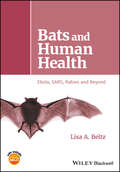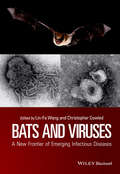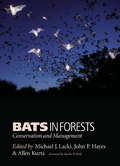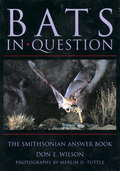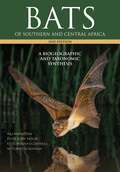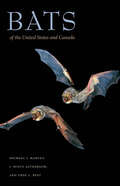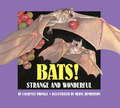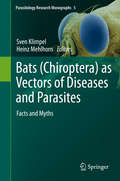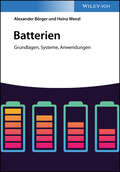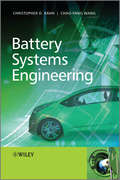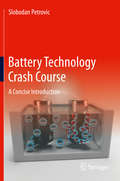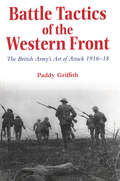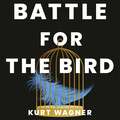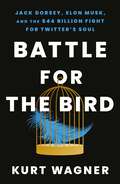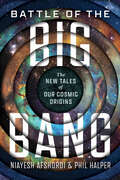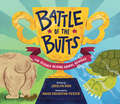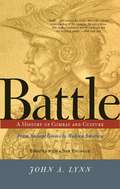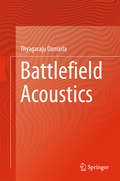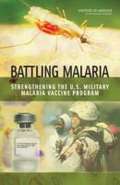- Table View
- List View
Bats and Human Health: Ebola, SARS, Rabies and Beyond
by Lisa A. BeltzAn important resource that reviews the various infectious diseases that affect bats and bat populations Bats and Human Health: Ebola, SARS, Rabies and Beyond covers existing literature on viral, bacterial, protozoan, and fungal infections of bats and how these infections affect bat populations. The book also offers an overview of the potential for zoonotic transmission of infectious diseases from bats to humans or domestic animals. While most prior publications on the subject have dealt only with bat viral infections, this text closely covers a wide range of bat infections, from viral and bacterial infections to protist and fungal infections. Chapters on viral infections cover rabies, filoviruses, henipaviruses, and other RNA viruses, as well as information on bat virome studies. The book then provides information on bacterial infections–including arthropod-borne and other bacteria that affect bats–before moving on to protist infections, including apicomplexans and kinetoplastids, and fungal infections, including white-nose syndrome, histoplasma capsulatum, and other fungi. Comprehensive in scope, yet another key feature of this book is a searchable database that includes bat species, bat family, bat diet, bat location, type and classification of infecting microbes, and categories of microbes. This vital resource also: Provides a history and comprehensive overview of bat-borne diseases Incorporates information from the World Health Organization, as well as historical data from the National Libraries of Health and infectious disease journals Covers a variety of diseases including viral infections, bacterial infections, protist infections, and fungal infections Written for microbiologist, bat researchers, and conservationists, Bats and Human Health provides a comprehensive exploration of the various types of microbes that affect bats and their potential to affect human populations.
Bats and Viruses
by Christopher Cowled Lin-Fa WangApproximately 75% of emerging infectious diseases are zoonoses, and the rate of emergence of zoonotic diseases is on the rise. Bats are being increasingly recognised as an important reservoir of zoonotic viruses of different families, including SARS coronavirus, Nipah virus, Hendra virus and Ebola virus. Understanding bats' role in emerging zoonotic diseases is crucial to this rapidly expanding area of research. Bats and Viruses: From Pathogen Discovery to Host Genomics provides an updated overview of research focusing on bat biology and the role bats play as hosts of many major zoonotic viruses. The text covers bat biology, immunology, and genomics. Chapters also delve into the various major bat-borne virus families, including lyssaviruses, paramyxoviruses, coronaviruses, filoviruses and reoviruses, among others. Edited by leaders in the field, Bats and Viruses: From Pathogen Discovery to Host Genomics is a timely, invaluable reference for bat researchers studying microbiology, virology and immunology, as well as infectious disease workers and epidemiologists, among others.n the area of bat biology and bats as a host of major zoonotic viruses. The book will cover a wide range of topics from bat biology, bat immunology, bat genomics to pathogen discovery and specific chapters on each of the major bat-borne virus families. The book will also provide a chapter remarking on the future direction of research in this important and rapidly growing area.
Bats in Forests: Conservation and Management
by Michael J. LackiAlthough bats are often thought of as cave dwellers, many species depend on forests for all or part of the year. Of the 45 species of bats in North America, more than half depend on forests, using the bark of trees, tree cavities, or canopy foliage as roosting sites. Over the past two decades it has become increasingly clear that bat conservation and management are strongly linked to the health of forests within their range. Initially driven by concern for endangered species—the Indiana bat, for example—forest ecologists, timber managers, government agencies, and conservation organizations have been altering management plans and silvicultural practices to better accommodate bat species. Bats in Forests presents the work of a variety of experts who address many aspects of the ecology and conservation of bats. The chapter authors describe bat behavior, including the selection of roosts, foraging patterns, and seasonal migration as they relate to forests. They also discuss forest management and its influence on bat habitat. Both public lands and privately owned forests are considered, as well as techniques for monitoring bat populations and activity.The important role bats play in the ecology of forests—from control of insects to nutrient recycling—is revealed by a number of authors. Bat ecologists, bat conservationists, forest ecologists, and forest managers will find in this book an indispensable synthesis of the topics that concern them.
Bats in Question: The Smithsonian Answer Book (Smithsonian's In Question Ser.)
by Don E. Wilson Merlin D. TuttleLong the subject of myth and superstition, bats have been among the most misunderstood of mammals due to their nocturnal habits, capacity for flight, and strange appearance. Seeking to dispel the myths associated with these remarkable creatures and arguing for their key role in a balanced ecosystem, Bats in Question covers all aspects of bat biology in a practical question-and-answer format.Describing where bats live, how they use echolocation to navigate, and even why they hang upside down, the book also gives the conservation status of all 925 bat species. Don E. Wilson traces the evolution of bats and shows their remarkable diversity by describing each of the major groups in terms of their different body structures and habitats. He sheds light on bats' complex social systems, extraordinary variation in size, and food preferences that encompass plants, insects, and mammals. The book also explores cultural attitudes about bats--telling how, until recently, bats had been relegated to the world of vampires and how they have emerged to take their place in public awareness as important and fascinating members of our ecosystems.
Bats of Southern and Central Africa: A biogeographic and taxonomic synthesis, second edition
by Dr. Ara Monadjem Dr. Peter John Taylor Dr. Fenton (Woody) Cotterill Dr. M. Corrie SchoemanThis revised edition of a book first published in 2010 supplements the original account of the 116 bat species then known to be found in Southern and Central Africa with an additional eight newly described species.The chapters on evolution, biogeography, ecology and echolocation have been updated, citing dozens of recently published papers. The book covers the latest systematic and taxonomic studies, ensuring that the names and relationships of bats in this new edition reflect current scientific knowledge. The species accounts provide descriptions, measurements and diagnostic characters as well as detailed information about the distribution, habitat, roosting habits, foraging ecology and reproduction of each species. The updated species distribution maps are based on 116 recorded localities. A special feature of the 2010 publication was the mode of identification of families, genera and species by way of character matrices rather than the more generally used dichotomous keys. Since then these matrices have been tested in the field and, where necessary, slightly altered for this edition. New photographs fill in gaps and updated sonograms aid with bat identification in acoustic surveys. The bibliography, which now contains more than 700 entries, will be an invaluable aid to students and scientists wishing to track down original research.
Bats of the United States and Canada
by Michael J. Harvey J. Scott Altenbach Troy L. BestHonorable Mention, Popular Science, 2012 PROSE Awards, Professional and Scholarly Publishing Division of the Association of American PublishersThe only mammals capable of true flight, bats are among the world’s most fascinating creatures. This accessible guide to the forty-seven species of bats found in the United States and Canada captures and explains the amazing diversity of these marvels of evolution.A wide variety of bat species live in the United States and Canada, ranging from the California leaf-nosed bat to the Florida bonneted bat, from the eastern small-footed bat to the northern long-eared bat. The authors provide an overview of bat classification, biology, feeding behavior, habitats, migration, and reproduction. They discuss the ever-increasing danger bats face from destruction of habitat, wind turbines, chemical toxicants, and devastating diseases like white-nose syndrome, which is killing millions of cave bats in North America. Illustrated species accounts include range maps and useful identification tips. Written by three of the world’s leading bat experts and featuring J. Scott Altenbach's stunning photographs, this fact-filled and easy-to-use book is the most comprehensive and up-to-date account of bats in the U.S. and Canada.
Bats! (Know It All)
by Roger GenerazzoA simple children's book about different kinds of bats, their habits, and other interesting facts.
Bats!: Strange and Wonderful (Strange and Wonderful)
by Laurence PringleLaurence Pringle takes a fascinating look at earth's only flying mammal in this fun and informative Parents' Choice Award book. Readers will learn how bats can pluck insects from the air, and even fish from the water. They will discover how bats help giant trees and other tropical plants to reproduce, and gobble up pesky mosquitoes. They will find out, too, how you can help to protect bats and their homes. Dozens of bats swoop through Meryl Henderson's striking illustrations. The colorful art and clear, concise text together demonstrate that bats may be strange, but that they are wonderful too, and well worth saving.
Bats: Facts and Myths (Parasitology Research Monographs #5)
by Sven Klimpel Heinz MehlhornThis book gathers contributions by 16 international authors on the phenomenon "bats," shedding some light on their morphology, the feeding behaviors (insects, fruits, blood) of different groups, their potential and confirmed transmissions of agents of diseases, their endo- and ectoparasites, as well as countless myths surrounding their lifestyle (e. g. vampirism, chupacabras, batman etc. ). Bats have been known in different cultures for several thousand centuries, however their nocturnal activities have made them mysterious and led to many legends and myths, while proven facts remained scarce. Even today, our knowledge of bats remains limited compared to other groups in the animal kingdom. Also, their famous ability to avoid collisions with obstacles during their nightly flights with the help of a sophisticated and unique system using ultrasound waves (which are transmitted and received) is as poorly studied as birds finding their way from continent to continent. In recent times, where globalization transports millions of people and goods from one end of the earth to the other, there are increased risks posed by agents of diseases, as a result of which bats have received increasing attention as potential vectors. These suppositions are based on their proven transmission of viruses such as rabies. In dedicated chapters, the book addresses the following topics: * The world of bats * The astonishing morphology of bats * Bats as potential reservoir hosts for vector-borne diseases * Bat endoparasites * Macroparasites - ectoparasites * Glimpses into how bats fly * Blood-licking bats * Vampirism in medicine and culture * Chupacabras and "goat milkers" * Myths on candiru As such, this book provides a broad range of information for all non-experts interested in biological topics, but also for people working in this field, as well as physicians and veterinarians who are confronted with clinical cases, and for teachers and students interested in expanding their knowledge of biology and of past and present cultures.
Batterien: Grundlagen, Systeme, Anwendungen
by Heinz Wenzl Alexander BörgerBatterien Für die Mobilität und Energieversorgung der Zukunft: Kompakte und praxisnahe Wissensvermittlung aller wichtigen Batteriegrundlagen und -systeme Batterien sind in vielen Fällen die bevorzugte Lösung zur technischen und wirtschaftlichen Optimierung von Fahrzeugen und Energieversorgungsystemen und ermöglichen es, Emissionen zu verringern und die Abhängigkeit von Erdöl und Erdgas zu reduzieren. In der Summe aller Eigenschaften erfüllen Blei-Säure-Batterien und Lithium-Ionen-Batterien die Anforderungen der verschiedensten Anwendungen am besten und dominieren deshalb den Markt. Lithium-Ionen-Batterien dringen in immer weitere Anwendungsgebiete vor, bzgl. Wert und Produktionsmenge in MWh dominieren aber immer noch Blei-Säure-Batterien. Aus Sicht der Autoren sind Kenntnisse beider Batterietechnologien wichtig, um das Verständnis für Batteriesysteme zu vertiefen und sie in den seltenen Fällen, in denen diese beiden Batterietechnologien technische oder wirtschaftliche Alternativen sind, gegeneinander abzuwägen. Die Anforderungen an Batteriesysteme sind hoch. Sie müssen leicht und häufig ladbar sein und müssen thermisch, elektrisch und mechanisch stabil sein. In der Batterieforschung kommt materialwissenschaftliches, elektrochemisches und Ingenieurwissen zusammen. Die Autoren Alexander Börger und Heinz Wenzl geben mit diesem Buch einen umfassenden und kompakten Überblick zu den Grundlagen, Systemen und Anwendungen der Batterietechnik. Es werden Hintergründe zum Aufbau von Batterien und grundlegende Prozesse anschaulich erläutert. Anhand vieler Beispiele wird gezeigt, wie das Wissen in die Praxis umgesetzt wird. Klarer Fokus: Das Buch legt den Schwerpunkt auf Batteriesysteme, ihre Eigenschaften im Betrieb und Anwendungen. Das Buch ist als Begleitlektüre zum Studium verwendbar. Wachstumsmarkt: Das Interesse an Elektromobilität und Batteriespeichern in der Stromversorgung wächst und damit auch der Bedarf an Batteriesystemen. Anwendungsnah: Fallbeispiele aus der aktuellen Batterieentwicklung setzen die Theorie in die Praxis um. Expertenwissen: Die Autoren verfügen über langjährige Erfahrung auf dem Gebiet der Batterietechnik. Batterien: Grundlagen, Systeme, Anwendungen richtet sich an Ingenieurinnen und Ingenieure zur Einarbeitung in die Materie und als Nachschlagewerk sowie an Studierende als Begleitlektüre zu Vorlesungen.
Batteries for Sustainability: Selected Entries from the Encyclopedia of Sustainability Science and Technology
by Ralph J. BroddBatteries that can store electricity from solar and wind generation farms are a key component of a sustainable energy strategy. Featuring 15 peer-reviewed entries from the Encyclopedia of Sustainability Science and Technology, this book presents a wide range of battery types and components, from nanocarbons for supercapacitors to lead acid battery systems and technology. Worldwide experts provides a snapshot-in-time of the state-of-the art in battery-related R&D, with a particular focus on rechargeable batteries. Such batteries can store electrical energy generated by renewable energy sources such as solar, wind, and hydropower installations with high efficiency and release it on demand. They are efficient, non-polluting, self-contained devices, and their components can be recovered and used to recreate battery systems. Coverage also highlights the significant efforts currently underway to adapt battery technology to power cars, trucks and buses in order to eliminate pollution from petroleum combustion. Written for an audience of undergraduate and graduate students, researchers, and industry experts, Batteries for Sustainability is an invaluable one-stop reference to this essential area of energy technology.
Battery Systems Engineering
by Chao-Yang Wang Christopher D. RahnA complete all-in-one reference on the important interdisciplinary topic of Battery Systems EngineeringFocusing on the interdisciplinary area of battery systems engineering, this book provides the background, models, solution techniques, and systems theory that are necessary for the development of advanced battery management systems. It covers the topic from the perspective of basic electrochemistry as well as systems engineering topics and provides a basis for battery modeling for system engineering of electric and hybrid electric vehicle platforms.This original approach gives a useful overview for systems engineers in chemical, mechanical, electrical, or aerospace engineering who are interested in learning more about batteries and how to use them effectively. Chemists, material scientists, and mathematical modelers can also benefit from this book by learning how their expertise affects battery management.Approaches a topic which has experienced phenomenal growth in recent yearsTopics covered include: Electrochemistry; Governing Equations; Discretization Methods; System Response and Battery Management SystemsInclude tables, illustrations, photographs, graphs, worked examples, homework problems, and references, to thoroughly illustrate key materialIdeal for engineers working in the mechanical, electrical, and chemical fields as well as graduate students in these areasA valuable resource for Scientists and Engineers working in the battery or electric vehicle industries, Graduate students in mechanical engineering, electrical engineering, chemical engineering.
Battery Technology Crash Course: A Concise Introduction
by Slobodan PetrovicThis book is a concise introductory guide to understanding the field of modern batteries, which is fast becoming an important area for applications in renewable energy storage, transportation, and consumer devices. By using simplified classroom-tested methods developed while teaching the subject to engineering students, the author explains in simple language an otherwise complex subject in terms that enable readers to gain a rapid understanding of batteries and the scientific and engineering concepts and principles behind the technology. This powerful tutorial is a great resource for engineers from other disciplines, technicians, analysts, investors, and other busy professionals who need to quickly acquire a solid understanding of the fast emerging and disruptive battery landscape.
Battle Tactics of the Western Front
by Paddy GriffithHistorians have portrayed British participation in World War I as a series of tragic debacles, with lines of men mown down by machine guns, with untried new military technology, and incompetent generals who threw their troops into improvised and unsuccessful attacks. In this book a renowned military historian studies the evolution of British infantry tactics during the war and challenges this interpretation, showing that while the British army's plans and technologies failed persistently during the improvised first half of the war, the army gradually improved its technique, technology, and, eventually, its' self-assurance. By the time of its successful sustained offensive in the fall of 1918, says Paddy Griffith, the British army was demonstrating a battlefield skill and mobility that would rarely be surpassed even during World War II.Evaluating the great gap that exists between theory and practice, between textbook and bullet-swept mudfield, Griffith argues that many battles were carefully planned to exploit advanced tactics and to avoid casualties, but that breakthrough was simply impossible under the conditions of the time. According to Griffith, the British were already masters of "storm troop tactics" by the end of 1916, and in several important respects were further ahead than the Germans would be even in 1918. In fields such as the timing and orchestration of all-arms assaults, predicted artillery fire, "Commando-style" trench raiding, the use of light machine guns, or the barrage fire of heavy machine guns, the British led the world. Although British generals were not military geniuses, says Griffith, they should at least be credited for effectively inventing much of the twentieth-century's art of war.
Battle for the Bird: Jack Dorsey, Elon Musk and the $44 Billion Fight for Twitter's Soul
by Kurt WagnerThe gripping corporate saga of Twitter's titans and their journey towards power, innovation, and controversy.'Comprehensive . . . a definitive history' The Times'Battle For The Bird is an absolute triumph of reporting and storytelling.' Ashlee Vance, bestselling author of Elon Musk'If you want to understand how one of the most powerful social networks in history managed to be such a dramatic corporate disaster, you must read Kurt Wagner's deeply reported inside story.' Sarah Frier, author of Financial Times and McKinsey 2020 Business Book of the Year No Filter: The Inside Story of Instagram__________On October 28th, hours after completing a $44 billion takeover of Twitter, Elon Musk Tweeted to his millions of followers 'The bird is freed.'Musk's takeover of Twitter was one of the most audacious and remarkable deals in tech history. The Battle for Twitter takes readers back to the very beginning and how we reached this point. It looks at the origins of the platform, the vision of its co-founder Jack Dorsey, and how it became a battleground for ideas, controversies, and viral moments that shaped the world we live in today.With meticulous research and unprecedented access, author Kurt Wagner paints a vivid portrait of power struggles, bitter rivalries, and ground-breaking decisions that have shaped the evolution of Twitter. From Musk's audacious tweets to Dorsey's enigmatic persona, Battle for The Bird uncovers the depths of their involvement, revealing the forces that have propelled them to the forefront of global attention. In this gripping corporate saga, delve into the minds of these visionary figures as they engage in a high-stakes battle for dominance, reshaping the very fabric of social media.__________
Battle for the Bird: Jack Dorsey, Elon Musk and the $44 Billion Fight for Twitter's Soul
by Kurt WagnerOn October 28th, hours after completing a $44 billion takeover of Twitter, Elon Musk Tweeted to his millions of followers 'The bird is freed.'Musk's takeover of Twitter was one of the most audacious and remarkable deals in tech history. The Battle for Twitter takes readers back to the very beginning and how we reached this point. It looks at the origins of the platform, the vision of its co-founder Jack Dorsey, and how it became a battleground for ideas, controversies, and viral moments that shaped the world we live in today.With meticulous research and unprecedented access, author Kurt Wagner paints a vivid portrait of power struggles, bitter rivalries, and ground-breaking decisions that have shaped the evolution of Twitter. From Musk's audacious tweets to Dorsey's enigmatic persona, The Battle for Twitter uncovers the depths of their involvement, revealing the forces that have propelled them to the forefront of global attention. In this gripping corporate saga, delve into the minds of these visionary figures as they engage in a high-stakes battle for dominance, reshaping the very fabric of social media.
Battle of the Big Bang: The New Tales of Our Cosmic Origins
by Niayesh Afshordi Phil HalperA thrilling exploration of competing cosmological origin stories, comparing new scientific ideas that upend our very notions of space, time, and reality. By most popular accounts, the universe started with a bang some 13.8 billion years ago. But what happened before the Big Bang? And how do we know it happened at all? Here prominent cosmologist Niayesh Afshordi and science communicator Phil Halper offer a tour of the peculiar possibilities: bouncing and cyclic universes, time loops, creations from nothing, multiverses, black hole births, string theories, and holograms. Along the way, they offer both a call for new physics and a riveting story of scientific debate. Incorporating insights from Afshordi’s cutting-edge research and Halper’s original interviews with scientists like Stephen Hawking, Roger Penrose, and Alan Guth, Battle of the Big Bang compares these models for the origin of our origins, showing each theory’s strengths and weaknesses and explaining new attempts to test these notions. Battle of the Big Bang is a tale of rivalries and intrigue, of clashes of ideas that have raged from Greek antiquity to the present day over whether the universe is eternal or had a beginning, whether it is unique or one of many. But most of all, Afshordi and Halper show that this search is filled with wonder, discovery, and community—all essential for remembering a forgotten cosmic past.
Battle of the Blanket Forts: A QUIX Book (Fort Builders Inc. #3)
by Dee RomitoWhen kids of Fort Builders, Inc., go to summer camp, a friendly blanket fort competition turns serious in the third story in the fun-to-read Aladdin QUIX chapter book series that&’s perfect for emerging readers!Kiara is super excited to go to Camp Firefly for the summer and be with all her friends, including the rest of Fort Builders, Inc. And this year, she can&’t wait to enter the camp-wide CREATE contest. One lucky team will win the prize of building something from scratch, using all the DIY skills they show in the competition. Kiara and her cabin decide compete by making the best blanket fort ever—but Caleb and his cabin decide to do the same thing! Can they learn to work together, or will this epic blanket fort battle turn into an all-out cabin war?
Battle of the Butts: The Science Behind Animal Behinds
by Jocelyn RishDid you know manatees swim using farts? Or that herrings communicate by passing gas?Butts are used for breathing, eating, swimming, talking, and even killing in the animal kingdom. Focusing on ten different animals and their derrières, and offering fun facts about their origin, habitat, and "posterior power," this hilarious book captures the wonder of our ecosystem. Which animal has the coolest butt power? That's up to you to decide!
Battle: A History of Combat and Culture
by John A LynnBattle: A History of Combat and Culture spans the globe and the centuries to explore the way ideas shape the conduct of warfare. Drawing its examples from Europe, the Middle East, South Asia, East Asia, and America, John A. Lynn challenges the belief that technology has been the dominant influence on combat from ancient times to the present day. In battle, ideas can be more far more important than bullets or bombs. Carl von Clausewitz proclaimed that war is politics, but even more basically, war is culture. The hard reality of armed conflict is formed by - and, in turn, forms - a culture's values, assumptions, and expectations about fighting. The author examines the relationship between the real and the ideal, arguing that feedback between the two follows certain discernable paths. Battle rejects the currently fashionable notion of a "Western way of warfare" and replaces it with more nuanced concepts of varied and evolving cultural patterns of combat. After considering history, Lynn finally asks how the knowledge gained might illuminate our understanding of the war on terrorism.
Battlefield Acoustics
by Thyagaraju DamarlaThis book presents all aspects of situational awareness using acoustic signals. It starts by presenting the science behind understanding and interpretation of sound signals. The book then goes on to provide various signal processing techniques used in acoustics to find the direction of sound source, localize gunfire, track vehicles and detect people. The necessary mathematical background and various classification and fusion techniques are presented. The book contains majority of the things one would need to process acoustic signals for all aspects of situational awareness in one location. The book also presents array theory, which is pivotal in finding the direction of arrival of acoustic signals. In addition, the book presents techniques to fuse the information from multiple homogeneous/heterogeneous sensors for better detection. MATLAB code is provided for majority of the real application, which is a valuable resource in not only understanding the theory but readers can also use the code as a spring-board to develop their own application based software code.
Battlefield Forensics for Persian Gulf States: Regional and U.S. Military Weapons, Ammunition, and Headstamp Markings
by Don Mikko William BaileyBattlefield Forensics for Persian Gulf States provides an illustrative reference of various weapons, toolmarks, headstamps, and other traits in order to identify the origins of a variety of guns, casings, and ammunition that can be found in the Middle East. Various conflicts in the region have led to innumerable weapons being used throughout the years. The lead author, Don Mikko, has investigated and examined firearms related items of evidence in countless crime scenes throughout the world. As the Chief of the Firearms Branch at the United States Army Criminal Investigation Laboratory (USACIL), Fort Gillem, Georgia, he recruited, trained, and competency tested military contractors deploying to various combat related areas of the world, those providing forensic firearm and toolmark identification support to local commanders. What was learned was that various foreign weapons and ammunition were being utilized in conflicts and by opposing forces. This book educates readers on the technical data for different types of firearms, ammunition, countries of origin, proof marks, penetrator information and the typical firearm markings imparted on fired cartridge cases, such as breech-face, firing pin, ejector, and extractor markings. Forensics and biometrics within the Persian Gulf have been leveraged since the early 1990s and many of the firearms and types of ammunition covered in this handbook are addressed in an effort to assist those on the ground who are required to be able to identify such items in various scenarios. The information contained within the book has proven to be effective on the battlefield and has helped shape combat operations. This handbook will serve as a useful reference not only to assist military and contractor personnel within the various combat locations but will also prove to be beneficial for law-enforcement, crime laboratory personnel, forensic firearm and toolmark examiners, crime scene investigators, students, practitioners, and civilian personnel throughout the world.
Battleships of the Scharnhorst Class: The Scharnhorst and Gneisenau: The Backbone of the German Surface Forces at the Outbreak of War (Warships Of The Kriegsmarine Ser.)
by Gerhard Koop Klaus-Peter SchmolkeIn this WWII naval history, an expert in German warship design examines the legendary battlecruisers Scharnhorst and Gneisenau. This concise yet authoritative summary of Scharnhorst class vessels covers the design history and careers of these WWII-era warships. Much like its companion volume, Battleships of the Bismark Class, it offers a detailed description of both ships with full technical details. The author also provides an outline of their combat service, heavily illustrated with plans, battle maps, and a substantial collection of photographs. The Scharnhorst and Gneisenau were the product of a long and complicated design process. Combining speed and power, these two battleships took part in a number of major operations, including the infamous &‘Channel Dash&’.
Battling Air and Water Pollution: Protecting Our Planet's Vital Resources
by Vir Singh R. K. Srivastava Arvind Kumar BhattThis book discusses growing environmental threats posed by air and water pollution, exploring their causes, impacts, and potential solutions. It covers a range of pollutants, from solid and liquid to gaseous and energy-based, while offering a clear analysis of their origins and effects. The chapters examine the global impact of pollution, highlighting the interconnectedness of air and water pollution and their combined effects on ecosystems and human health. It also discusses economic, social, and health-related costs along with practical solutions for pollution management. This book serves as a valuable resource for environmentalists, policymakers, graduate and postgraduate students, as well as anyone looking to deepen their understanding of environmental challenges.
Battling Malaria: Strengthening The U.s. Military Malaria Vaccine Program
by Institute of Medicine of the National AcademiesThe National Academies Press (NAP)--publisher for the National Academies--publishes more than 200 books a year offering the most authoritative views, definitive information, and groundbreaking recommendations on a wide range of topics in science, engineering, and health. Our books are unique in that they are authored by the nation's leading experts in every scientific field.
